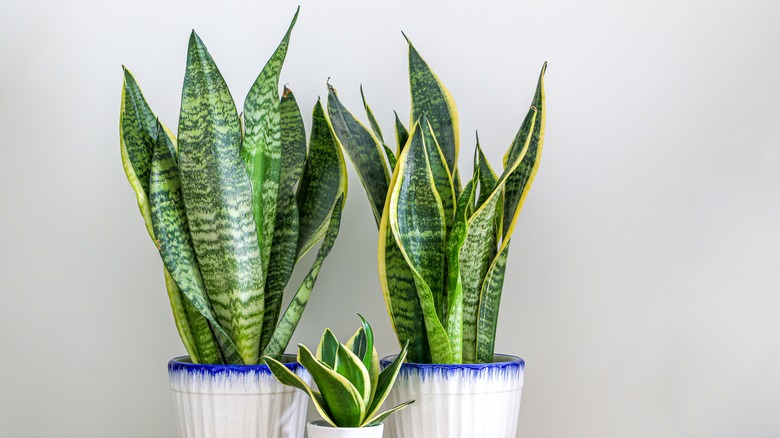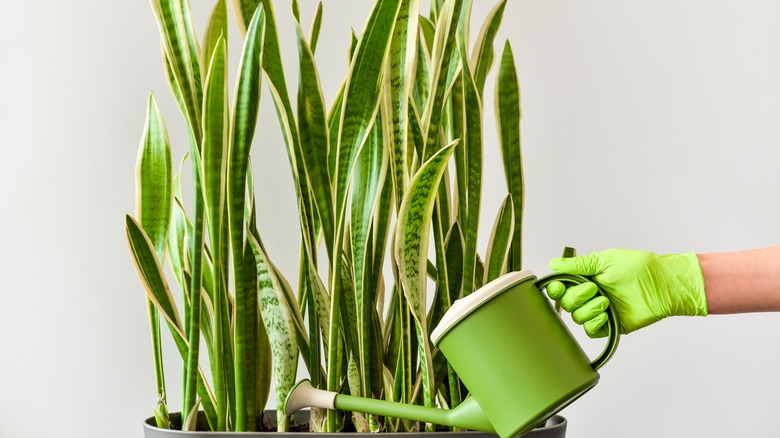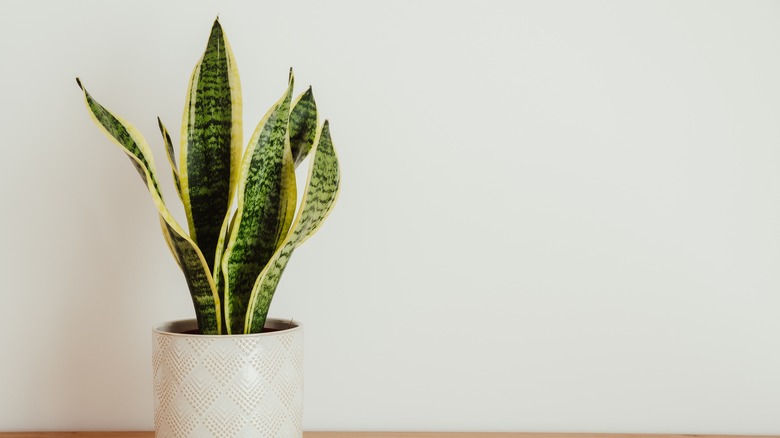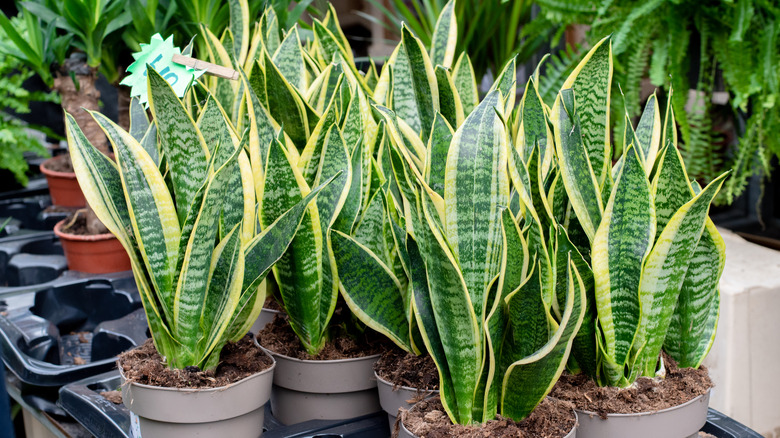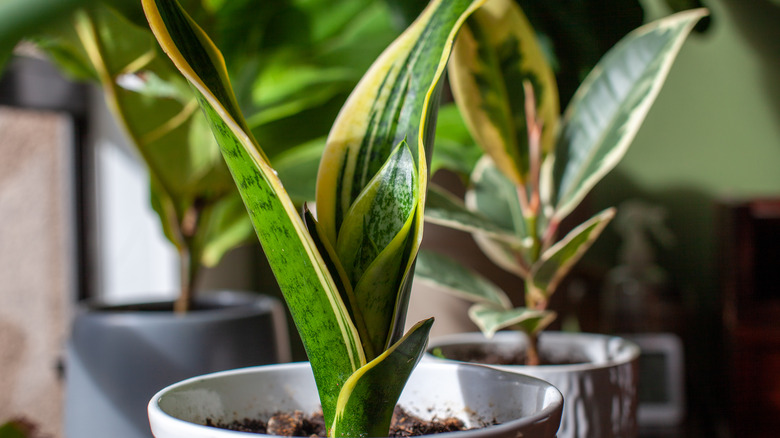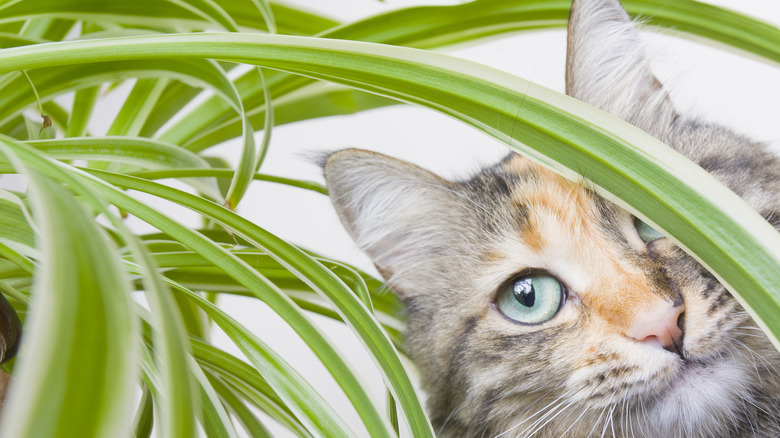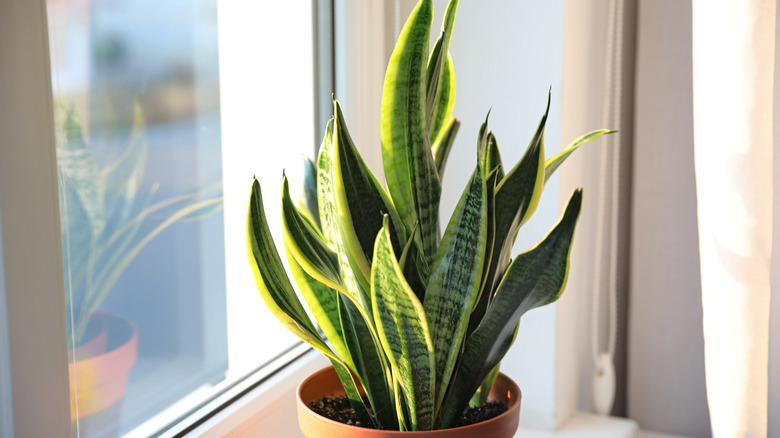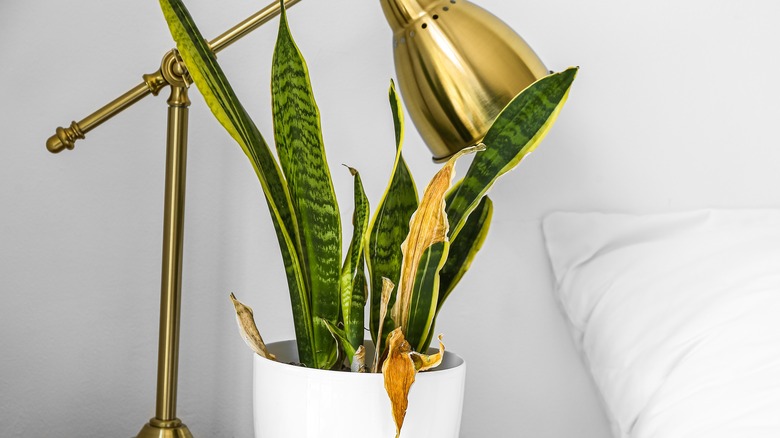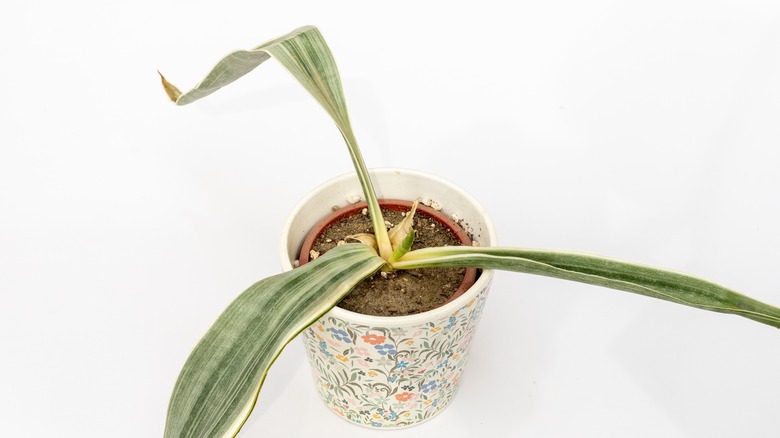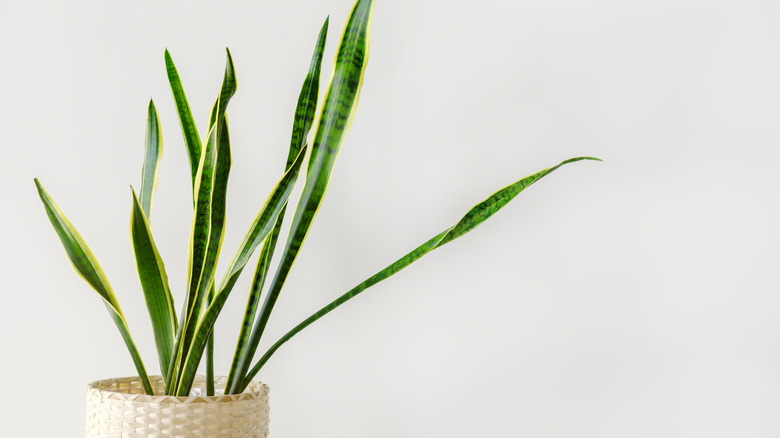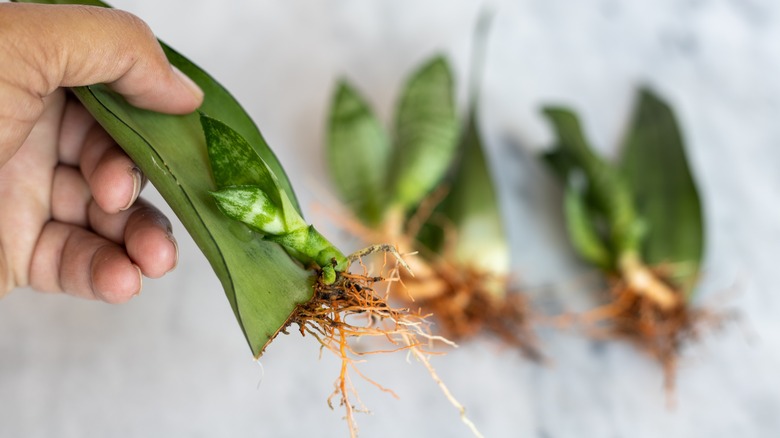12 Issues You Should Know About Before Growing Snake Plants
Snake plants, or sansevieria, offer a wide array of benefits. In addition to being a neat-looking plant that can enhance the overall look of your home, they can also convert carbon dioxide to oxygen. But, before you rush off to your nearest garden center to buy one (or several) snake plants, there are a few things you'll want to know.
There are quite a few potential issues that home gardeners may run into when growing snake plants. Some of these potential problems relate to finding the proper way to care for the plant, while others could impact how much you'll enjoy raising a snake plant. Read on to learn more about some of these problems that you may run into when growing a snake plant and what you may (or may not) be able to do to overcome them so you can decide whether this is the right plant for your indoor or outdoor garden.
Watering them properly can be difficult
Even if you're a novice gardener, you know that plants need water to grow. However, watering a snake plant isn't as easy as it is for other types of plants. Snake plants are very particular when it comes to how much water they need. Think of them as the Goldilocks of the plant world: if you don't get it just right, they're not going to thrive and could potentially die.
The biggest watering issue you could run into with your snake plant is overwatering it. If they are given too much water, root rot may form. You also can't just completely neglect your snake plant and forget about watering it either. Instead, you need to strike the right balance. Give the soil time to dry out before watering the plant again. The plant will store sufficient water in its leaves to last for several days. Once the top few inches of soil are dry, you can water your plant. During the warmer months, you should check on the soil starting about five days after watering to see when the plant is ready for more water. In the winter, the snake plant will be able to go longer between waterings.
They can be picky about pot size and soil type
As shared above, if snake plants get too much water, they may develop root rot. However, overwatering is not the only thing that can lead to root rot in your snake plant. If you don't choose the right type of soil, it is also possible that your plant will be plagued with this issue. It is essential to choose a well-draining soil that won't hold too much water. Otherwise, the plant could get waterlogged, leading to root rot, fallen leaves, and other serious problems.
You should also take care when choosing a pot for your snake plant. Snake plants have the potential to grow to be quite large, reaching up to 3 feet tall when grown as houseplants, though in their native environment, they can grow up to 10 feet wide and 12 feet tall. They may eventually need a large pot up to 18 inches across and 24 inches deep. However, if your snake plant is still small, you should avoid choosing a pot that is overly large. It will require too much soil that could hold too much water, bringing up the threat of root rot once more. A good rule of thumb is to choose a pot that's one to two inches larger in diameter than the plant's root ball.
They don't always produce flowers
If you're looking for a flowering plant to add some color to your home or outdoor garden, a snake plant may not be the best choice for you. If you've heard that snake plants produce pretty white flowers, you may be confused to hear they aren't the best choice. And, while you're not wrong that snake plants can flower, it isn't necessarily going to happen. In fact, it is very rare for a snake plant to flower, so those that do see this beautiful occurrence should consider themselves lucky.
Moreover, even snake plants that will eventually flower, may not do so for several years. The plants (and their flowers) can grow slowly, especially under less-than-ideal growing conditions. If you get a snake plant, you may have to wait it out patiently for a few years to see if you'll be lucky enough to spot flowers. Sadly, there is no trick (or at least no known trick) to coax a snake plant into flowering. It can all come down to the plant's age, along with the pure luck of the draw.
They don't grow well in hot temperatures
When growing a snake plant, it is important to make sure that it is not in a space that is going to get too hot or too cold. Snake plants originated in Africa, meaning they are used to warmer weather without the threat of freezing or frosts. It is important to keep the room temperature above 60 degrees when growing a snake plant. If they remain in temperatures lower than 60 degrees for too long, the plant's growth will slow. If the temperature gets even a little colder — under 50 degrees — it can cause serious damage to the leaves. So, don't forget about a snake plant that you brought outside in the spring or summer. If it is left out in the cold winter and exposed to freezing temperatures, it is likely that the plant won't make it to the following spring.
Warmer temperatures are generally fine for snake plants. However, if they are in direct sunlight and the temperature is over 100 degrees for an extended period of time, it could threaten their health. When keeping a snake plant indoors, aim to keep the temperature between 65 and 85 degrees. As long as you put a snake plant in an area where temperatures aren't too extreme in either direction, they should be fine.
They may be impacted by several pests of fungi
One important part of caring for a snake plant is regularly checking it for any signs of a pest or fungal infestation. Unfortunately, there are several different pests and fungi that can threaten these plants. There are several species of sap-sucking pests that you should look out for. Sap-sucking pests include aphids, spider mites, thrips, whiteflies, and mealybugs. The bugs drink plant sap and are able to multiply quickly, meaning a few can quickly turn into an infestation. Sap-sucking pests also release honeydew on the leaves. This is a sticky substance that can cause sooty mold to grow over the snake plant.
Southern blight is one type of fungus that snake plants may develop. The fungus starts as white patches with black dots, which grow larger and then cause the leaves to change to brown or gray. Snake plants are more likely to develop southern blight in warm and humid climates. If you notice signs of southern blight on your snake plant, be sure to prune off any affected leaves before it has the opportunity to spread.
Powdery mildew is another type of fungus that can grow on snake plants. However, it is more common in climates where the temperature is cool, the humidity levels are higher, and there isn't much light. Powdery mildew doesn't look attractive, but it doesn't pose a serious threat to snake plants as long as you remove any affected parts of the plant. You can also help get rid of it by choosing an area with more sunlight for your snake plant and trying to decrease humidity levels.
They are poisonous to people and animals
If you have young children or pets, you may want to reconsider your desire to get a snake plant. They are considered toxic to humans and pets. The Saponin chemicals present in the leaves have the potential to poison anyone who eats or chews on them.
While snake plants are only seen as mildly poisonous to humans, according to the American Kennel Club, they are more toxic to animals, including dogs and cats. If the leaves are ingested, it can cause the animals to suffer from diarrhea, nausea, or vomiting. In rare cases, dogs could also suffer from ruptured red blood cells after ingesting plant materials. If your dog or cat ingests any part of a snake plant, you should seek veterinary care, particularly if they are showing any stomach irritation symptoms or having swelling in their mouth or throat.
Even though they are only considered slightly toxic to humans, they still may not be the right choice for homes with young children. Because of their smooth and bright leaves, a child may be attracted to the plant and try eating it. If children exhibit signs of nausea, vomiting, diarrhea, or excess saliva, seek medical attention.
Maintaining appearance takes effort
Snake plants are known for their tall green leaves. However, helping the leaves maintain their gorgeous appearance can take some effort and there are many potential obstacles that can stand in the way. Sometimes, the leaves can look almost stretched out. They can become taller, thinner, and less attractive and healthy-looking. This can occur if the plant doesn't get enough sunlight for photosynthesis to take place, so if you notice longer and stretched-out looking leaves, move your plant to a spot where it will get more sun.
Overwatering can cause several potential leaf-related issues. Overwatering can weaken a snake plant's leaves. If the leaves hold too much water, they can turn mushy and weak. In some cases, this condition can also occur if the snake plant is in a very humid environment. Yellowed leaves can also be a sign of overwatering. If the plant's roots rot and aren't able to move the necessary nutrients to the leaves, they could change to a yellow color.
The leaves may turn brown
When you have a snake plant, you want to show off its gorgeous, green leaves. However, that can be difficult if those once gorgeous, green leaves are now brown. In some cases, brown splotches can cover some of the leaves on a snake plant. Other times, the tips of several leaves may turn brown. Both of these will leave your snake plant looking sad and distressed.
Such damage can be caused by improper care during transport. In other cases, exposure to extreme weather conditions — namely frost — is to blame. When snake plants are left out in freezing temps, the cold can cause some of the cells in their leaves to become frozen. As the weather warms up and the plant defrosts, you may see brown spots in the damaged areas of the leaves. Sadly, if the leaves are brown, there is nothing you'll be able to do to get them to turn back to green as the cells are already permanently damaged. The best thing you can do is to cut the entire leaf off to leave a spot for a new one to grow in the future.
The plant is prone to wilting
Yet another leaf-related issue with snake plants is the potential for the leaves to wilt. Wilted leaves are wrinkled and often drooping down, rather than standing straight and tall, as you would expect. There are a few potential issues that can cause the leaves on this type of plant to wilt. The first relates to temperature. If the weather is too warm or sunny for multiple days in a row, it can cause a snake plant to go into heat stress. Temperatures that are too cold can also have the same effect. These extreme temperatures can kill the tissues in the leaves, giving them a droopy appearance.
Another possible problem that can cause the leaves to wilt is too much moisture. This is another example of why you should let the soil dry out in between waterings. If it is saturated in too much water and the roots begin to rot, they won't be able to transfer water to the leaves as normal, which can cause them to shrivel and droop.
The leaves may start to curl and twist
There is still another potential snake plant leaf problem that you should know about. Sometimes, the leaves of the plants may twist, bend, or curl. Considering snake plants are supposed to have long and straight leaves, this is clearly not something that you want to have happen. As with other leaf problems, there isn't necessarily a clear-cut explanation for this issue. A few different factors could be to blame.
Cold temperatures and underwatering can both cause the leaves of a snake plant to twist or curl. In the case of cold weather, young leaves are particularly susceptible to curling if temperatures are too low. And, unfortunately, if this happens before the plant is well-established, those leaves will remain curled throughout its life. If the curling leaves are the result of underwatering, it is likely that the curl will also be accompanied by brown tips. Similarly, if your snake plant is getting too much sunlight, it can dry out more quickly. This can lead to the same effect as underwatering, curling the leaves, and turning their tips brown.
A pest infestation — particularly of thrips — could also be the cause of twisted or curled leaves. If you've ruled out watering, sunlight, or temperature as the cause of the curling leaves, consider treating the plant for an infestation, even if you don't see any evidence of the pests. They are very small and good at hiding, so they can be easy to miss. Neem oil works effectively on thrips and won't threaten the health of the snake plant.
Propagation can be difficult
Propagation is a process that refers to taking a cutting from a parent plant and rooting it to allow a new plant to grow. While this is possible with a snake plant, it isn't a good task for a beginner to attempt. It is very easy to damage the plant during the process by cutting the leaves wrong. Plus, the new snake plants that grow might not have variegations on their leaves, which can make them less attractive.
If you do manage to successfully clip a cutting from the plant, then you'll also need to decide whether you want to propagate it in water or soil. Each option has its own set of pros and cons, which can add new challenges to the mix. While propagating in water is the easiest option and makes it possible to see the root growth, it is also going to take the longest amount of time to produce a new plant that is ready to be potted in soil. Soil propagation makes it possible to grow different snake plant variations in the same pot, but it doesn't allow you to visually track the growth of the roots.
Some people believe they bring bad luck
Do you consider yourself superstitious? If not, then you'll probably just disregard this potential snake plant issue right after you read it. However, if you are superstitious or don't want to tempt fate, you might decide that a snake plant isn't the right choice for you. Some people believe that they can bring bad luck to a home if they are kept inside. The reasoning is that snake plants attract negative energy, thus threatening the well-being of the home and those in it.
Feng Shui practices also point to some negative aspects of snake plants. This Chinese system that is designed to create the best flow and energy in a home through the arrangement of furniture states that because of their negative energy, snake plants should never be put in a bedroom. Of course, these are just superstitions, and there have not been any scientific studies to back up these assertions. Take them with a grain of salt, if you'd like.
